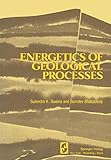Energetics of geological processes Hans Ramberg on his 60th birthday Libro electrónico editores: Surendra K. Saxena, Somdev Bhattacharji, Hans Annersten, Ove Stephansson
Tipo de material: Libro
en línea Idioma: Inglés Detalles de publicación: New York, New York, United States Springer-Verlag c1977Descripción: xviii, 473 páginas ilustraciones 25 centímetrosISBN:
Libro
en línea Idioma: Inglés Detalles de publicación: New York, New York, United States Springer-Verlag c1977Descripción: xviii, 473 páginas ilustraciones 25 centímetrosISBN: - 9783642865763 (Print)
- 9783642865749 (Online)
- Disponible en línea
Incluye bibliografía e índice: páginas 471-473
Chapter 1. Energetics of geodynamic processes.. 1. Gravitational instability and the development of the structure of continents (attempt at a synthesis.. 2. Intrusion into moving crust.. 3. A possible use of structure factors in constitutive equations for rocks.. 4. Geometric patterns of active strike-slip faults and their significance as indicators for areas of energy release.. 5. Strain analysis in an experimentally deformed oolitic limestone .. 6. Drag patterns of planar structures around rigid inclusions.. 7. Progressive deformation and development of fabric across zones of shear in glacial ice.. 8. The structural analysis of metamorphic rocks in orogenic belts.. 9. A model for the development of the seve-köli caledonian nappe complex.. 10. Subduction-zone ophiolites and island-arc ophiolites.. Chapter 2. Energetics of geochemical processes.. 11. Heat flow-heat generation studies in norway.. 12. Disproportionation equilibrium in iron-bearing systems at pressures above 100 Kbar with applications to chemistry of the earth's mantle.. 13. Compositional variables and chemical equilibrium in metamorphism.. 14. Thermodynamic control of metamorphic processes.. 15. The mathematics of cation diffusion and exchange between silicate minerals during retrograde metamorphism.. 16. From crucibles through subduction to batholiths.. 17. Equilibrium thermodynamic calculations applied to meteorite mineral assemblages.. 18. A new electronegativity scale for geochemists.. Index
Disponible para usuarios de ECOSUR con su clave de acceso
Hans Ramberg is working in an area of geology where 60 years are a short, often negligible period of time. This is not so in the lives of men. For us it is a time for evaluating past accomplishments and a time for friends to express their appreciation and admiration. Some universities have become famous for this ability to foster eminent scientists in one or several fields. The success of Cambridge University in physics is a well-known example, but if we ask ourselves whether the success of Oslo University in earth sciences is not equally astonishing, then we see that Hans is yet another example of this process; but it is not the whole story. There were certainly promising prospects when he started his studies in geology: V. M. Goldschmidt had just come back from G6ttingen in Germany and Tom Barth had returned from the Geophysical Laboratory in Washington, D.C. Two leaders in geochemistry and petrology at the same time! Hans became a student of Barth, specializing in metamorphic rocks and their problems; but soon the situation changed. Norway was occupied by the Germans and the possibili ties for university studies almost vanished. However, in spite of all difficulties he obtained his Ph.D. in 1946 and began participating in the geological mapping of Greenland. In 1947 he went to the University of Chicago and stayed there until 1961 when he came to his present position in the University of Uppsala, Sweden. Inglés
Disponible en línea
Disponible en formato PDF


